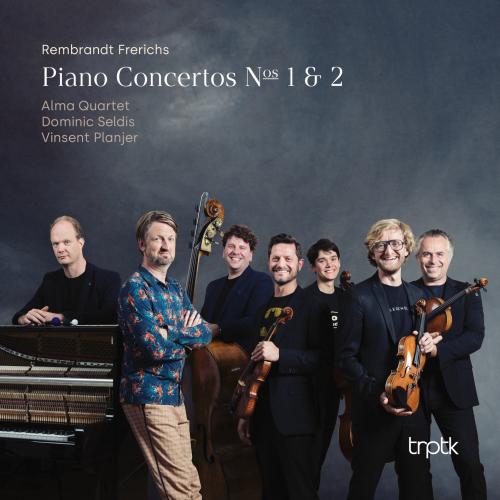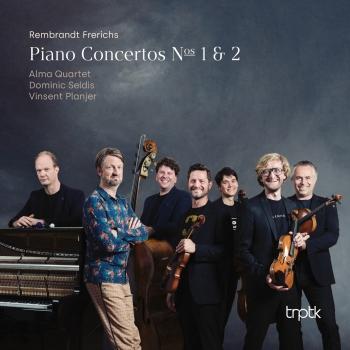
Frerichs: Piano Concertos Nos. 1 & 2 Rembrandt Frerichs, Alma Quartet, Dominic Seldis and Vinsent Planjer
Album info
Album-Release:
2021
HRA-Release:
22.04.2022
Label: TRPTK
Genre: Classical
Subgenre: Concertos
Artist: Rembrandt Frerichs, Alma Quartet, Dominic Seldis and Vinsent Planjer
Composer: Rembrandt Frerichs (1977)
Album including Album cover Booklet (PDF)
- Rembrandt Frerichs (b. 1977): Piano concerto No. 1:
- 1 Frerichs: Piano concerto No. 1: I. Textures and registers 03:38
- 2 Frerichs: Piano concerto No. 1: II. Cadenza I 02:32
- 3 Frerichs: Piano concerto No. 1: III. Bohemia theme 04:55
- 4 Frerichs: Piano concerto No. 1: IV. Cadenza II 02:47
- 5 Frerichs: Piano concerto No. 1: V. Elasticity 03:52
- 6 Frerichs: Piano concerto No. 1: VI. A wind sweeps us through the world 05:36
- 7 Frerichs: Piano concerto No. 1: VII. Musique au font 09:28
- 8 Frerichs: Piano concerto No. 1: VIII. Blue pencilled outlines 07:13
- Piano concerto No. 2 "Eternal variating alternations":
- 9 Frerichs: Piano concerto No. 2 "Eternal variating alternations": I. 1st Movement 05:47
- 10 Frerichs: Piano concerto No. 2 "Eternal variating alternations": II. 2nd Movement 04:23
- 11 Frerichs: Piano concerto No. 2 "Eternal variating alternations": III. 3rd Movement 06:18
- 12 Frerichs: Piano concerto No. 2 "Eternal variating alternations": IV. 4th Movement 03:25
Info for Frerichs: Piano Concertos Nos. 1 & 2
For pianist and composer Rembrandt Frerichs (1977), a new musical adventure began when viola player Michael Gieler invited him for an open conversation. Gieler is a solo violist with the Royal Concertgebouw Orchestra and leader of the IJ-Salon series, a cross-border ‘playground’ of chamber music with musicians of the Royal Concertgebouw Orchestra. Gieler planted a seed that grew into a composition commission for Rembrandt’s first Piano Concerto. Rembrandt took up the challenge.
Rembrandt Frerichs already came into the spotlight through composition commissions from leading musicians, including Liza Ferschtman and Amsterdam Sinfonietta. His star is rising further now that musicians of the Royal Concertgebouw Orchestra have asked him to compose a brand new piano concerto that features himself as soloist.
It is a logical consequence of his artistic choices over the past decade that Rembrandt has come to be known as a forward-thinking free spirit for musicians who want to break out of the confines of their professional practice. In his projects, he makes every effort to test both his own limits and those of his fellow musicians. On this album this can be heard, for example, on the track “Finale,” where the strings are plunged into a rhythmic world not yet common to classical musicians.
Rembrandt: “Mahler’s Fourth is well-known territory for these musicians. We have known for a hundred years what it is supposed to sound like. For improvising musicians, everything they make is living material that can constantly change. We afford ourselves more liberties. And we know, the wrong note is where the adventure begins! In the second piano concerto, you can hear a great example of living material in the 3rd movement when the strings hold a long note and they have no idea what I’m going to do with that note.”
It’s easy to forget, but imagine that you could travel in a time machine to a Beethoven or Mozart concert and you would notice that Ludwig and Wolfgang mainly played their own work. Moreover, they often did not have a notated piano score. Later, one of these performances was transcribed and notated for publishing purposes. This score, passed on from generation to generation, has led to the widespread misconception that in what we now call classical music all the notes were always the same.
The approach Rembrandt takes here goes back to the original performance practice of the great masters. It shows that classical and jazz are not as far apart as is often thought.
As in their time, a performance of the piano concerto is an experience of tailor- made music for the individual piano soloist. Because of the improvisations, no two concerts are the same. An illustrative example of this is the 3rd movement of the first piano concerto “Musique au font”, where a joint improvisation begins from 3:20.
Rembrandt: “For a long time it was unclear how the concert would sound in its entirety. The string players didn’t have a picture of the embedding of the piano yet. At the rehearsals I would say something like: I’m going to do something here, but what that is I’ll figure out during the concert. The penny didn’t drop until we played for an audience for the first time at the Oranjewoud festival and the musicians heard the piece in its entirety. You could truly read on their faces, ‘Aaaah so this is what he meant…’ That moment can be heard during the second movement of the piano concerto no. 2.”
As a listener, you experience the musical battle between ensemble and piano; an exhilarating ritual dance of two partners. A new path is taken as improviser Rembrandt combines the best of two worlds with the classical musicians on stage. As with Ravel, Debussy and Gershwin, the composer himself sits at the piano.
Rembrandt: “I want to take the audience into my ‘Black page / white page’ approach, which is to say that the listener is aware that the classical musicians on stage have an actual part with black dots on paper. I, on the other hand, have a completely blank page. I re-imagine the conversation with the orchestra each concert, providing musical commentary and a counterpoint, as on ‘Cadenza 2’ from the first piano concerto. Classical pianists play from a score. With my piano concerto, I take a clear stand in order to shake up performance practice by involving the audience in the creation process. In doing so, I am following the practice of both Mozart and Beethoven, who usually did not write out their piano parts either: they knew the parts of all the other instruments by heart but only created their parts during the concert. My starting point in this is my many years of improvised jazz background, which I bring to the fore in the last movement of the 1st piano concert, ‘Blue Pencilled Outlines’. In how this comes together, that adventure, we take the listener with us during our concerts.”
Rembrandt Frerichs, piano
Marc Daniel van Biemen, 1st violin
Benjamin Peled, nd violin
Jeroen Woudstra, viola
Clément Peigné, cello
Dominic Seldis, double bass
Vinsent Planjer, percussion
Rembrandt Frerichs
(1977) is a pianist with a broad perspective. He focuses his energy on ideas that are meaningful to him and his artistic journey is constantly deepening into new areas. Through his collaboration with Michael Brecker at the age of only 25 and a double concert with Chick Corea in London, Rembrandt is familiar with the American jazz tradition, but he wants to avoid well-trodden paths. Rembrandt's knowledge of the music of different parts of the world pushes his compositions to continually evolve, pushing the boundaries of classical, improvised and world music.
At the age of 22, Rembrandt made his debut at the North Sea Jazz Festival. During this time he was awarded the Outstanding Young Musician Scholarship to study in New York City. Immediately after graduation, he was asked to teach at various music universities. Currently, Rembrandt is a professor at the Utrecht Conservatory.
His debut album, released in 2006, was nominated for the Dutch Grammy (Edison Award). Rembrandt's music has taken him to some of the world's legendary jazz clubs, such as Birdland in New York, Ronnie Scotts in London and festivals and clubs in Europe, America and the Far East. In 2017, his Rembrandt Frerichs Trio was the opening act at the Taiwan Jazz Festival, where he performed in front of 50,000 people.
The summer of 2013 marked the beginning of a new artistic journey: the Contemporary Forte Piano.
Rembrandt's deep interest in exploring different ways of playing the piano is supported by his constant research. His interest in the sound of early music and oriental instruments such as the santur and qanun led him to the fortepiano. Rembrandt now brings elements of Baroque and Middle Eastern music into his improvised sets, collaborating with the masters of Persian music Kayhan Kalhor and Hossein Alizadeh. The Dutch National Instrument Fund is so enthusiastic about this new direction that it had a fortepiano built especially for Rembrandt.
As a composer, his compositions have been performed and recorded by classical as well as world and jazz musicians. Among them: Violinists Liza Ferschtman, Hugo Ticciati (UK), Antoinette Lohmann, Niek Baar and Rosanne Philippens, Holland Baroque, Nederlands Kamer Orkest, Cello 8tet, Remy van Kesteren, Mahan Esfahani (UK), the Osiris Trio, the Storioni Trio, Ties Mellema, Frode Halti (NOR), Izhar Elias, Levan Tskhadadze (GRG), Dominic Seldis (UK), Rick Stotijn, Amstel Quartet, Matangi Quartet, Zapp String Quartet, Hermine Deurloo, Klaartje van Veldhoven, Kayhan Kalhor (Iran), Hossein Alizadeh, Mahsa Vahdat, Paolo Fresu (IT), Trygve Seim (NOR), Norma Winstone (UK), Perico Sambeat (ESP) and Jim Black (US).
His music has also been used for theatre pieces in Japan and by the Tanzkompanie Bielefeld (Germany).
In 2004 he was invited to tour Brazil and Europe with the European Jazz Youth Orchestra, working with Hermeto Pascoal.
Booklet for Frerichs: Piano Concertos Nos. 1 & 2












